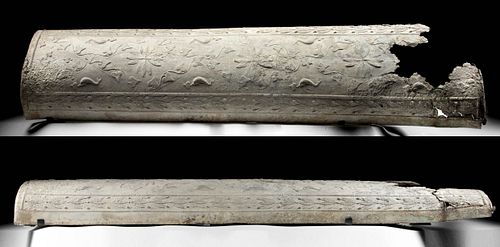Rare & Large Roman Lead Domed Sarcophagus Lid w/ Frame
Lot 49
About Seller
Artemis Fine Arts
686 S Taylor Ave, Ste 106
Louisville, CO 80027
United States
Selling antiquities, ancient and ethnographic art online since 1993, Artemis Gallery specializes in Classical Antiquities (Egyptian, Greek, Roman, Near Eastern), Asian, Pre-Columbian, African / Tribal / Oceanographic art. Our extensive inventory includes pottery, stone, metal, wood, glass and textil...Read more
Estimate:
$19,000 - $28,500
Absentee vs Live bid
Two ways to bid:
- Leave a max absentee bid and the platform will bid on your behalf up to your maximum bid during the live auction.
- Bid live during the auction and your bids will be submitted real-time to the auctioneer.
Bid Increments
| Price | Bid Increment |
|---|---|
| $0 | $25 |
| $300 | $50 |
| $1,000 | $100 |
| $2,000 | $250 |
| $5,000 | $500 |
| $10,000 | $1,000 |
| $20,000 | $2,500 |
| $50,000 | $5,000 |
| $100,000 | $10,000 |
| $200,000 | $20,000 |
About Auction
By Artemis Fine Arts
Mar 24, 2022
Set Reminder
2022-03-24 10:00:00
2022-03-24 10:00:00
America/New_York
Bidsquare
Bidsquare : Exceptional Antiquities Ethnographic Fine Art
https://www.bidsquare.com/auctions/artemis-gallery/exceptional-antiquities-ethnographic-fine-art-9057
Museum-worthy examples of classical antiquities (Egyptian, Greek, Roman, Near Eastern), Viking, Far East / Asian, Pre-Columbian, African / Tribal, Oceanic, Native American, Spanish Colonial, Fossils, Ancient Jewelry, Fine / Visual Arts, so much more! Artemis Fine Arts info@artemisfinearts.com
Museum-worthy examples of classical antiquities (Egyptian, Greek, Roman, Near Eastern), Viking, Far East / Asian, Pre-Columbian, African / Tribal, Oceanic, Native American, Spanish Colonial, Fossils, Ancient Jewelry, Fine / Visual Arts, so much more! Artemis Fine Arts info@artemisfinearts.com
- Lot Description
Roman, Imperial Period, ca. 2nd to 3rd century CE. How exciting! An astonishing lead sarcophagus lid in a rare, nearly complete form! Almost 6 feet in length, this massive casket cover boasts a rectangular form with a convex face saturated in relief decoration of traditional Roman iconography. Meticulously rendered, the decorative program features sinuous vines of ivy leaves that meander across the central channel, crisscrossing in 3 places to divide the plane into rhomboid quadrants. A symmetrical floral motif formed from 12 laurel leaves embellishes 3 of the main quadrants, while 6 sections are instead each filled with the adorable image of a diving dolphin holding an ivy leaf in its mouth. Modern metal frame included. Size: 67.4" L x 15.8" W (171.2 cm x 40.1 cm)
This is all framed by additional decoration with the 2 longer peripheries each featuring a row of a repeated laurel branch motif inspired by the actual garlands and flowers used to decorate tombs and altars, framed by 2 finely delineated borders of cable molding or ropework - perhaps a stylized memory of ropes intended to tie up the coffin. These lovely cable moldings additionally line the shorter peripheries, in effect acting as frames to the central decorative program.
Prior to the 2nd century, Romans cremated their dead; around that time, they became inspired by the Greek and Etruscan practice of using sarcophagi, and they began to make lead coffins. This trend spread rapidly throughout the Roman Empire. In the western part - where this panel likely came from, based on the leaf motif - sarcophagi were placed inside a mausoleum against a wall or in a niche. The leaves refer to actual garlands and flowers used to decorate tombs and altars. The dolphins, meanwhile, remind us of a powerful and common motif in Roman artwork. The Romans were largely a maritime empire, and the iconography of the sea included dolphins. Romans believed these animals carried souls to the Fortunate Isles, perhaps because they could pass through the air-breathing terrestrial world and into the watery depths that claimed so many Roman sailors' lives. This symbol must have had personal significance for the deceased, who often ordered lead coffins to be made long before they died - the process of making them required such a long time that they could not be rushed!
Cf. Metropolitan Museum of Art, 65.148a–f, Dumbarton Oaks, BZ.1941.2, and Rijksmuseum Van Oudheden, B1902/2.1.
Provenance: private Naples, Florida, USA collection, acquired 1980s
All items legal to buy/sell under U.S. Statute covering cultural patrimony Code 2600, CHAPTER 14, and are guaranteed to be as described or your money back.
A Certificate of Authenticity will accompany all winning bids.
PLEASE NOTE: Due to recent increases of shipments being seized by Australian & German customs (even for items with pre-UNESCO provenance), we will no longer ship most antiquities and ancient Chinese art to Australia & Germany. For categories of items that are acceptable to ship to Australia or Germany, please contact us directly or work with your local customs brokerage firm.
Display stands not described as included/custom in the item description are for photography purposes only and will not be included with the item upon shipping.
#168909Losses to upper right corner. Right end repaired from a few pieces with break lines visible and several stable fissures. Minor stable fissure to center and a few more to left side. Expected nicks and abrasions as well as some light softening of detail, all commensurate with age. Otherwise, excellent with rich patina. Modern metal frame secured to back and peripheries accompanies lid for mounting and framing purposes.Condition
- Shipping Info
-
All shipping is handled in-house for your convenience. Your invoice from Artemis Gallery will include shipping calculation instructions. If in doubt, please inquire BEFORE bidding for estimated shipping costs for individual items.
-
- Buyer's Premium



 EUR
EUR CAD
CAD AUD
AUD GBP
GBP MXN
MXN HKD
HKD CNY
CNY MYR
MYR SEK
SEK SGD
SGD CHF
CHF THB
THB













